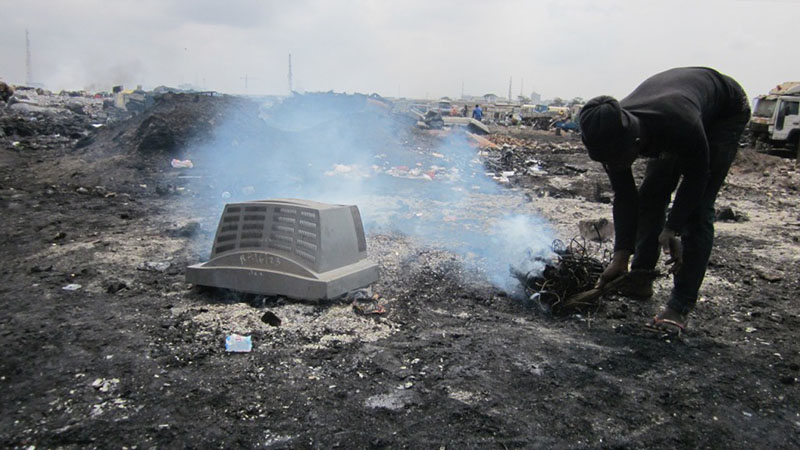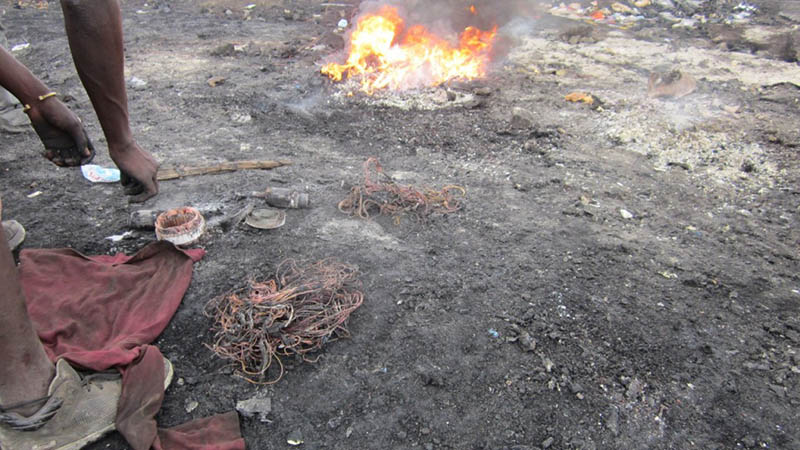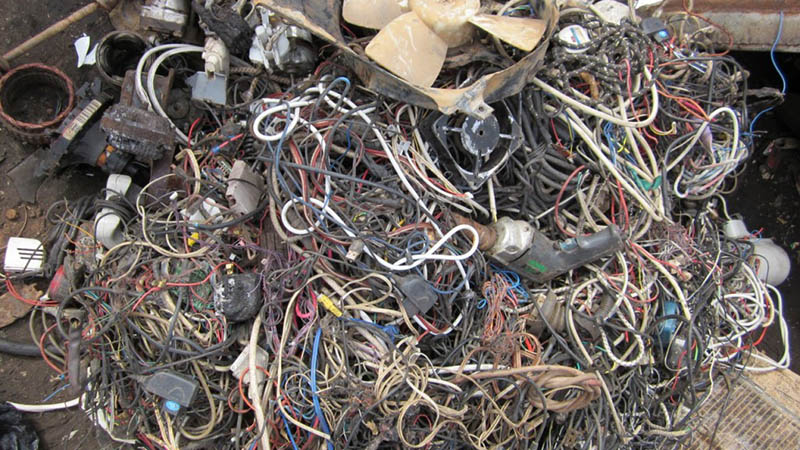Peter Little is an anthropologist and assistant professor at Rhode Island College, and author of Toxic Town: IBM, Pollution, and Industrial Risks (NYU Press 2014). I asked him a few questions about his new project on electronic waste recycling in Ghana. His answers touch on the politics of electronics waste and pollution, surprising links between first and second projects, and the challenge of doing fieldwork in a place that everyone’s talking about. Our conversation below has been edited for length and clarity.

The main burn site at Agbogbloshie. Photo by Peter Little.
Emily Brooks: What was the genesis of your second project? How did you move from Endicott [the field site for Toxic Town] to Ghana?
Peter Little: The original project was on a high tech production site, a birthplace of electronics. That led me in to thinking more about the lifecycle of electronics, from production to discard. When we think of electronic waste, China pops up, of course, but more and more, I started to notice West Africa and Ghana. I came across a circus of journalists and other social scientists focusing in on this Agbogbloshie scrap yard in Ghana in Accra, which had been branded by one journalist as “a mass electronics graveyard.” The site was the focus of a major international Greenpeace report in the 2000s, around the time when electronic waste really started to be reported on, to become a much more targeted dimension of waste distribution. When I recognized it as a problem related to my original research, I thought, why not try to do something there?
Part of my thinking about this classic lifecycle idea is that these scrap yards are not end-of-life zones. They’re places of revaluation and transformation. They’re really boundaries and edges; they’re not endpoints. So, there’s a way of thinking about this like, “oh, I read a book about a birthplace, and now I’m gonna go to the graveyard!” But, it really has changed my thinking about the ridiculousness of endpoints. There’s more edges.
EB: What has your early fieldwork been like? What are you focusing on?
PL: I’m focusing specifically on the effect of this NGO, Pure Eearth.org—which was actually founded by a former IBM executive—that’s set up an electronic waste recycling facility in the scrap yard. The main approach to copper mining here is to collect cable wiring, and burn off all of the plastic sheathing to get at that valuable copper. So, this NGO swooped on in to mitigate air pollution caused by folks in the scrap yard, who were engaged in electronics copper mining.

Igniting a pile of electronic wiring. Photo by Peter Little.
There’s connective fiber to Pure Earth and IBM and the theme of risk mitigation. Preventing burning is the major project that Pure Earth is engaging in there. They’re a solutions-based international environmental NGO; they specifically target “the most polluted places on Earth,” and Agbogbloshie has been slated one of the most polluted places on Earth.
The region where the scrap yard is is a former Ga settlement. The Ga are major coastal peoples who have lived in the coastal Accra area for a long time, and some call the area of Agbogbloshie “evil land,” largely because it’s a lagoon area that floods a lot. Currently, it’s a very tainted area because it’s also where all of Accra’s municipal solid waste ends up. It’s maintained this “tainted land,” it’s sustained that sort of symbolism of wasteland. In fact, some say this wasteland symbolism has become a major foothold in further legitimizing the city government’s planned evictions and demolitions in the nearby settlement called Old Fadama, where most scrap workers live or “squat” while they temporarily work before heading back to their villages in northern Ghana. The primary authority carrying out these evictions and demolitions is the Accra Metropolitan Authority (or AMA).

Recovering copper. Photo by Peter Little.
But, when you go there, the scrap yards are really vibrant places of creative revaluation. People turn things in to rubber sandals, there’s old electrical wiring being turned into speed bumps to be put in neighborhoods. People are doing extremely creative things. Many people have attempted to define these spaces as “makerspaces,” instead of simply the accumulation of discard. There’s another group in the area called the Agbogbloshie Makerspace Platform, which is made up of some really creative engineers and folks, and they’re trying to do lots of creative things. In this postcolonial scrap yard zone, the Makerspace folks are, in an interesting way, trying to assist with recognizing and supporting scrap workers as not just human beings—not just displaced humans and humans experiencing continued exploitation – but as craftsmen and craftswomen. This idea that they’re productive. Not just inhabiters of a wasteland.
I’m starting to develop some thinking around “electronic necropolitics” as another way to think about postcolonial discard studies. This is thrusting me in to a whole area of literature that is new to me. Which is why this is exciting! I really feel like I’m at the start of a totally new chapter of research, thinking, and rethinking the links between electronics production and plunder in Endicott and electronics recycling and pollution response in Agbogbloshie.
EB: Did it surprise you to find all of those connections between the Endicott project and this one?
PL: Not really! The mitigation effort in Endicott was totally solutions-based: solve the problem, fix it, done. “We did what we were told.” It’s totally a solutions-based, quick fix approach in Agbogbloshie, except it’s riddled with a ton of problems.

E-waste recycling facility. Photo by Peter Little.
EB: What are the problems?
PL: Pure Earth set up this big facility in October 2014. It originally had three cable-stripping machines in the facility, with the hope that, instead of copper wire burners burning, and contributing to the air pollution problem, they would bring their copper cables to the facility. The problem is, out of roughly 5,000 people who are engaged in the scrap yard doing burning and waste collection, only four or five were trained in how to use the machines. The whole facility is under lock and key. Originally, the only machines they had were ones that could feed large diameter cables, and most of the burners are burning smaller diameter sizes. So the thing wasn’t really being used! The only customer they were getting was the Ghanean electrical utility company.
And Pure Earth is a very point source pollution control NGO. And there are point source politics! They targeted the air pollution plumes from electronic waste collectors and burners as the source that needs mitigation, right? One of the groups that works in the scrap yard is a whole different operation. It has nothing to do with electronic waste; it has to do with goats, and cattle herding, and this process called wele. Wele is a delicacy. It’s burnt, hairless goat skin.
Twenty yards from where the [cable] burning goes on, there’s this whole operation going on, where goats are bought and sold in a goat market fifty yards from the burn site. Someone buys these goats, and they bring them over to this other facility. The goats get slaughtered, and then they get torched to burn off the hair. So, you have this other major, ongoing, more consistent plume of smoke, which is twenty yards away, that’s burning tires! This NGO has come in and is just targeting this one point source [for copper wire cables], but twenty yards away is this other operation. No one wants to go talk to them. They created this mud wall around their slaughtering facility. It has no roof, so you can see the continuous plume of smoke.

The usual tangle of wires. Photo by Peter Little.
EB: You mentioned this standard media narrative of what’s going on in Agbogbloshie. How does what you’re seeing respond to that narrative?
PL: The e-waste problem in Agbogbloshie, as geographers and discard studies experts Josh Lepawsky and Grace Akese have noted, is quite exaggerated. There’s a West African journalist who writes for The Atlantic, who wrote an article called “Inside a massive electronics graveyard.” He writes, “people work here in what looks like hell…this is the place where thousands of tons of the world’s electronics go to die.” That just isn’t true. The bulk of the waste showing up at the scrap yard is automobiles and car waste. Accra has become totally overrun with cars and taxis. There’s electronics in cars, and people are stripping the hell out of these cars, but this idea that it’s monitors and Apple computers showing up is a total distortion. So, some people have really started to think critically about how Agbogbloshie is being represented. Getting in to this project, I’m right in the middle of representation politics, and thinking about ethnography as a method for correcting distortion.
It’s rewriting the whole idea of the Basel Convention, because that was originally set up to put a clamp on the developed countries shipping their waste to developing countries. But, what’s really going on with regards to transboundary movements of e-waste is that the bulk of this waste is not moving from developed to developing countries. Instead, the data now shows that it’s movement between developing countries that dominates the transboundary trade of this discard material. It’s Nigeria and Ghana trading with each other, or Mexico and Peru, or India and Ghana. These findings turn the classic idea of developed dumping on the developing on its head. When it gets down to it, on the ground in Agbogbloshie, you really have to be there to see what’s going on and to understand what scrap workers in the electronics recycling sector are actually dealing with in their everyday lives.
Little returns to Ghana this July to continue his work. You can read more about his research here.
